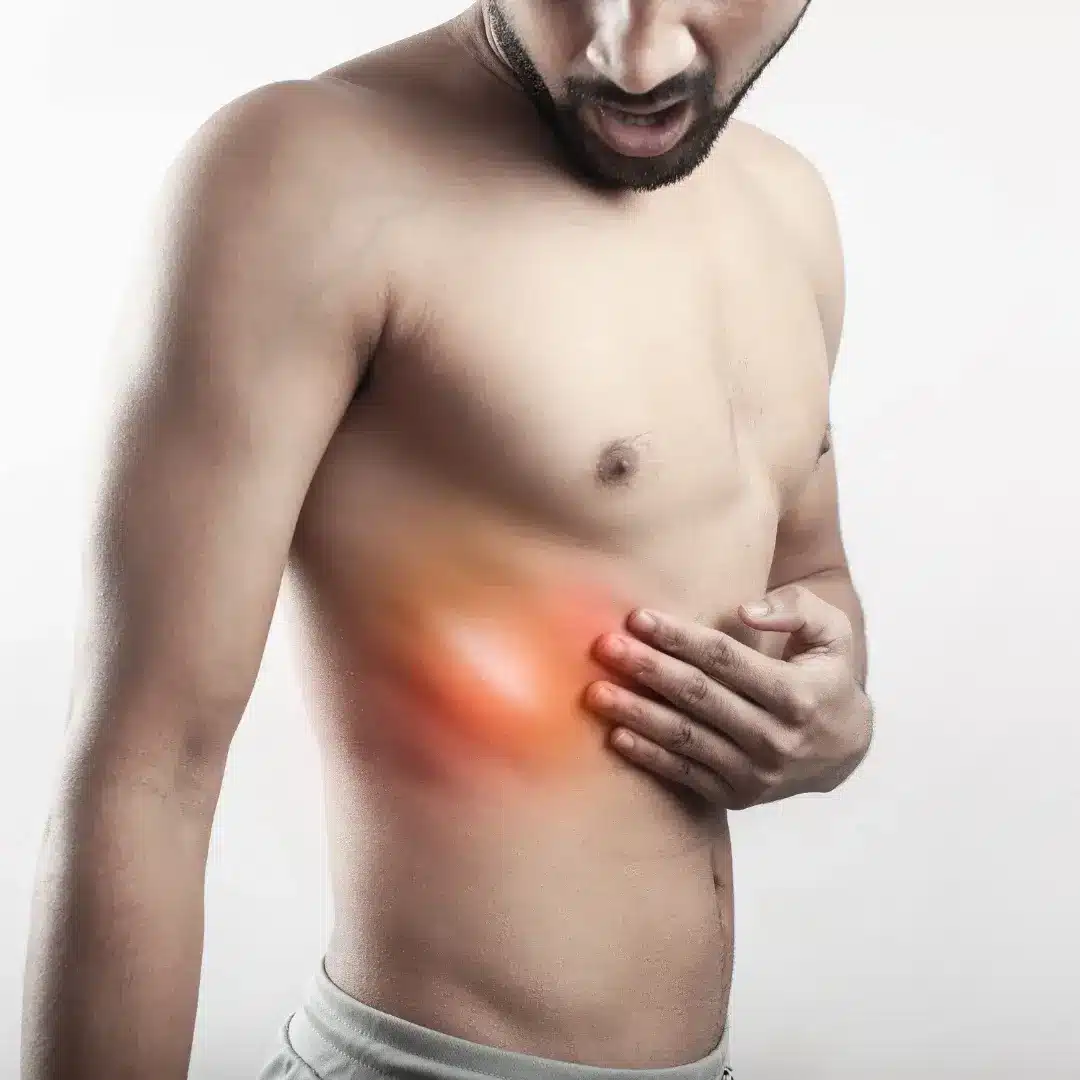Overview:
A rib out, also known as rib subluxation or rib misalignment, occurs when one or more ribs move out of their normal position where they articulate with the spine or sternum. This condition can result in localised pain, discomfort, and restricted movement in the affected area. Understanding the causes, symptoms, and management of rib misalignment is essential for relieving pain and restoring normal rib function.
Anatomy:
The rib cage, composed of 12 pairs of ribs, protects vital organs such as the heart and lungs and provides structural support for the thoracic cavity. Each rib attaches to the thoracic vertebrae in the back and articulates with the sternum or other ribs in the front, forming the ribcage. Ligaments and muscles surrounding the ribs help stabilise and facilitate movement of the rib cage during breathing and other activities.
Causes:
Rib misalignment can occur due to various factors, including:
- Trauma or injury: Sudden impact or force to the chest or back, such as a fall, motor vehicle accident, or sports injury, can dislodge or misalign one or more ribs.
- Repetitive strain: Overuse or repetitive motions involving the upper body, such as heavy lifting, twisting, or repetitive overhead activities, can strain the muscles and ligaments supporting the ribs, leading to subluxation.
- Poor posture: Slouching or rounded shoulder posture can alter the alignment of the thoracic spine and ribcage, increasing the risk of rib misalignment.
- Muscular imbalances: Weakness or tightness in the muscles surrounding the rib cage, such as the intercostal muscles or muscles of the back and chest, can disrupt rib alignment and stability.
- Structural abnormalities: Congenital abnormalities, spinal curvature disorders such as scoliosis, or degenerative changes in the spine can affect rib positioning and contribute to rib subluxation.
Symptoms:
Common symptoms of a rib out may include:
- Localised pain or discomfort in the chest or back, often exacerbated by movement or deep breathing.
- Tenderness or swelling at the site of rib misalignment.
- Restricted range of motion or difficulty performing activities that involve chest or upper body movement.
- Sharp or stabbing pain with certain movements or palpation of the affected area.
- Muscle spasms or guarding in the surrounding muscles as a protective response to rib instability.
Diagnosis and Tests:
Diagnosing a rib out involves a comprehensive evaluation of symptoms, medical history, and physical examination by a healthcare provider or manual therapist. Diagnostic tests may include:
- Palpation: Gentle palpation of the ribcage and surrounding muscles to identify tender areas, asymmetries, or abnormalities indicative of rib misalignment.
- Range of motion assessment: Evaluating chest and upper body movement to assess for restrictions or limitations associated with rib subluxation.
- Orthopaedic tests: Performing specific orthopaedic tests, such as rib compression test or rib springing test, to elicit pain or reproduce symptoms associated with rib dysfunction.
- Imaging studies: X-rays, CT scans, or MRI may be ordered to rule out fractures or structural abnormalities and assess the alignment of the rib cage and thoracic spine.
Management and Treatment:
Treatment for a rib out aims to realign the displaced rib, alleviate pain, and restore normal function. Management options may include:
- Manual manipulation: Gentle hands-on techniques, such as chiropractic adjustments or osteopathic manipulative therapy, can be used to mobilise and manipulate the ribs back into proper alignment.
- Soft tissue therapy: Myofascial release, trigger point therapy, or massage techniques may help relieve muscle tension, reduce inflammation, and promote relaxation of the surrounding soft tissues.
- Therapeutic exercises: Stretching and strengthening exercises targeting the muscles of the chest, back, and abdomen can improve posture, enhance rib stability, and prevent recurrent rib subluxation.
- Breathing exercises: Diaphragmatic breathing or deep breathing techniques can promote relaxation of the intercostal muscles and facilitate rib mobility and expansion, reducing discomfort associated with rib misalignment.
- Pain management: Nonsteroidal anti-inflammatory drugs (NSAIDs), analgesics, or topical pain relievers may be recommended to alleviate pain and inflammation associated with rib subluxation.
- Rest and activity modification: Avoiding aggravating activities or movements that exacerbate rib pain and allowing adequate rest and recovery can facilitate healing and prevent further irritation of the affected area.
Prevention:
Preventive measures for rib misalignment include:
- Maintaining good posture: Practising proper posture habits, such as sitting and standing tall with the shoulders back and the chest lifted, can reduce strain on the ribcage and prevent postural imbalances that contribute to rib subluxation.
- Strengthening exercises: Performing regular exercises to strengthen the muscles of the chest, back, and core can improve overall muscular support and stability of the ribcage, reducing the risk of rib misalignment.
- Ergonomic modifications: Using proper lifting techniques, adjusting workstation ergonomics, and avoiding repetitive movements that strain the upper body can minimise the risk of rib injury and subluxation.
- Injury prevention: Wearing appropriate protective gear during sports or activities that pose a risk of chest or back injury, such as contact sports or heavy lifting, can help prevent traumatic rib subluxation.
Outlook / Prognosis:
The prognosis for rib misalignment depends on the severity of the subluxation, underlying causes, and response to treatment interventions. With prompt diagnosis and appropriate management, most individuals experience significant improvement in symptoms and functional outcomes within a few weeks. However, recurrent rib subluxations or unresolved underlying issues may require ongoing treatment and preventive measures to prevent future episodes and promote long-term musculoskeletal health.
Living With:
Living with a rib out may require temporary modifications to activities or movements that exacerbate symptoms and adherence to recommended treatment strategies to promote healing and prevent recurrence. By practising good posture habits, incorporating therapeutic exercises, and addressing contributing factors such as muscle imbalances or poor biomechanics, individuals can effectively manage rib misalignment and minimise discomfort, allowing for a return to normal activities and improved quality of life.

